In Argentina, gender pay gap is 25%, but the situation changes (and a lot) depending on the province. If we talk about labor inequalities, salary is not what has the greatest impact. Unpaid workday is the main explanation for gender inequality. What is women’s work like in the Argentine provinces? An index of Gender, Work and Income.
Gender inequality has gained unprecedented public visibility in recent years. Despite this, the challenges posed by this agenda cannot be addressed without a map indicating where to focus efforts. We need measurements that accurately reflect the different dimensions of Argentine reality and its subnational heterogeneity. The Subnational Gender Equality Index (ISIG) aims to fill this gap by spotlighting gender gaps in each of the 24 jurisdictions, providing a quick reference for urgently needed public policy interventions. This second version of the index focuses on work and income. It rates for the first time with a single score the economic gender inequality at the provincial level in Argentina.
Gender, work and income
Transforming an insurmountable challenge into policy opportunities
The past years have witnessed a remarkable surge in civil society and the public sector’s commitment to gender issues. Today, envisioning or planning for the country’s development without taking equity into consideration is inconceivable. However, tackling inequality, a complex and multifaceted phenomenon, presents significant and unique challenges for public policy.
Evidence serves as a compass to guide priorities from among related issues and build political will at the national and local levels. The Gender, Labor and Income Index (IGTI) seeks to reframe this challenge from an insurmountable one to one addressable through public policy. The task at hand involves reconstructing an easily readable map of challenges nationwide shedding light on areas for intervention and identifying issues that require immediate prioritization.
Another challenge is understanding the dynamics of each jurisdiction. This index is subnational: it compiles and produces local information, offering a descriptive baseline on economic gender inequality in the country’s 24 jurisdictions. The purpose is to provide evidence to inform decision-making and policy monitoring.
An index to measure economic inequality
The IGTI aims to assess gender equality across 24 jurisdictions in terms of labor market access, distribution of unpaid housework, and poverty. Unlike a measure of general well-being, the IGTI compares the situation of women with that of men, regardless of the starting point, so that parity can coexist with low varying income levels.
Due to the lack of official sources detailing the situation of transvestites, trans, and non-binary individuals in the labor market, the index relies on binary gender data.
Considering regional realities
The findings reveal that no jurisdiction exhibits equality in terms of women’s labor market participation, poverty rates, and the distribution of unpaid housework. There is a 22.4-point gap between the current state and average parity across all jurisdictions, and an 11.4-point gap between the highest- and lowest-ranking jurisdictions. This difference highlights a higher level of homogeneity among the provinces in comparison to other aspects of gender equality, such as representation and decision-making power, where the gap between the best- and worst-ranking provinces rises to almost 30 points.
Upon initial examination of the data, it is evident that there is no clear correlation between wealth and economic development, as measured by GDP per capita, and gender equality in Argentina. Addressing financial inequalities requires a more detailed analysis of each province’s particular productive matrix.
In a quick matching exercise, when we look at the map of productive specialization and the IGTI score, we see that most provinces with agricultural and industrial-extractive specialization tend to be more egalitarian, whereas those with an agro-industrial profile lean toward greater inequality. While not deterministic or causal, these observations underscore the importance of considering productive policy when addressing gender inequality at the economic level.
Labor market access
Men and women enter the labor market in a very unequal manner, with men working longer paid hours and earning higher salaries, especially in provinces with higher remuneration levels. In spite of this, once they gain effective access to the market, formal employment seems to impact both genders equally, with access to labor rights showing closer parity (when measured in connection with formal jobs).
Activity: Labor market, the main barrier to accessing the labor market
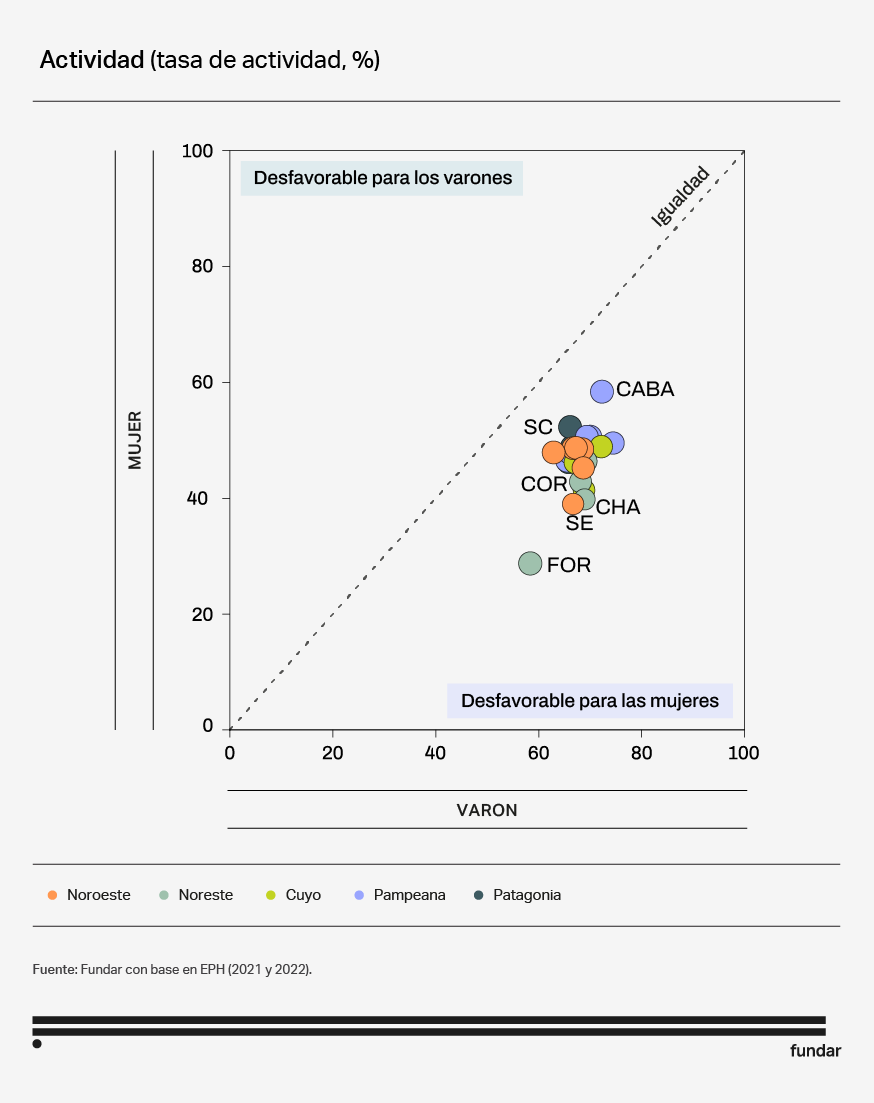
If we look in detail at the different variables that make up labor market insertion, we observe that the activity rate is the most unequal indicator with an average ratio of 68.8 points. The national average for men is 67.7%, while for women it is 46.6%, with values ranging from 28% in Formosa to 58% in CABA.
Notably, this indicator emphasizes the persisting challenge of women’s limited participation in remunerated activities, either employed or seeking employment. In other words, all provinces share a large percentage of women outside the labor market, leading to high levels of so-called “inactivity”, despite probably performing invisibilized and unpaid work.
First, the provinces with the lowest activity rates for women are also the most unequal in terms of activity. Conversely, the provinces closest to attaining equality have the highest activity rates for women.
Second, two identical values of equality may conceal disparate realities. Participation does not follow the same patterns in all provinces. In some provinces where few women are employed, they still have similar conditions to their male counterparts (Chaco, Formosa), while others have a higher participation rate but conditions are strikingly unequal (Córdoba, Entre Ríos).
Labor formality: closer to parity
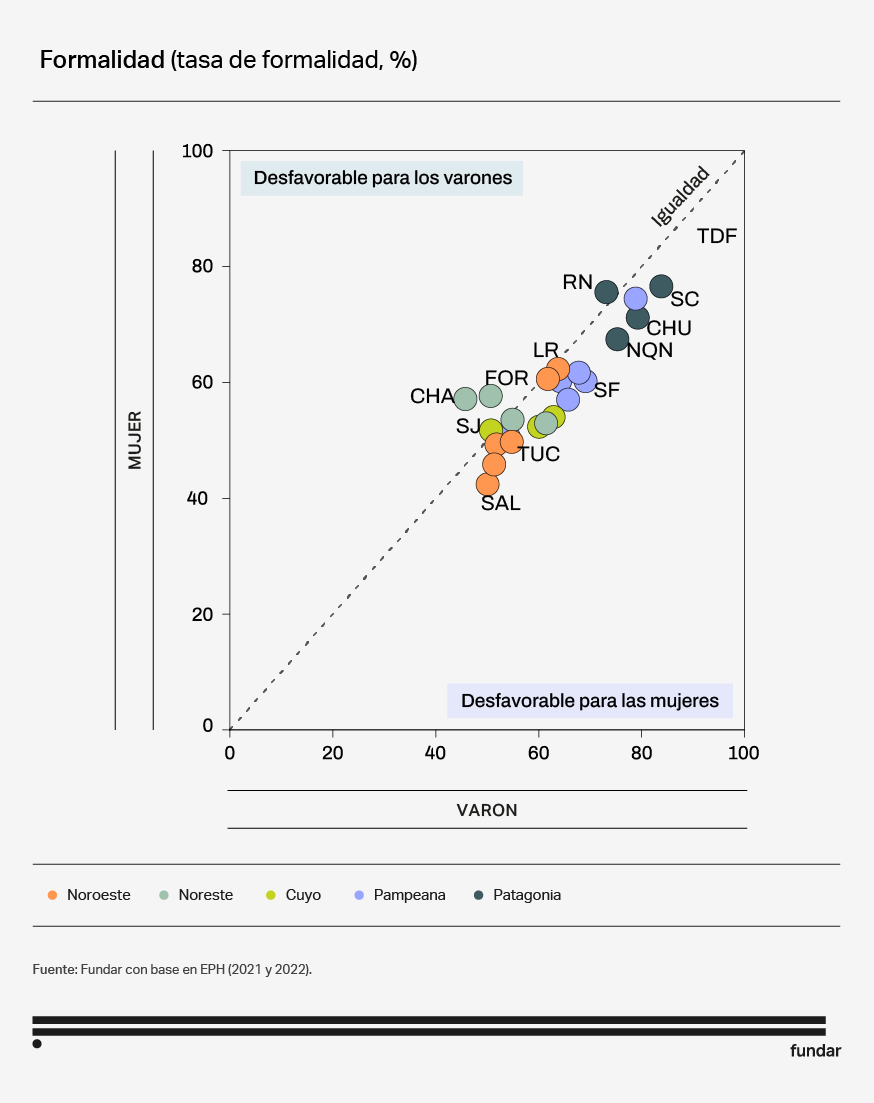
The formality indicator, with the highest average score of 92.6, approaches total parity in some provinces. Notably, Chaco, Formosa, Río Negro, and San Juan achieve total parity in formality. However, the overarching challenge in this case remains women’s participation in the labor market.
The high levels of formal employment among women may be attributed to the greater weight of public employment compared to other economic sectors. This is due to the fact that most women in formal employment are registered public servants, with the majority working in traditionally feminized sectors such as Education, Health, and Security. The rates of formality and public employment of women are significantly correlated.
Workday: the 9 hours difference

Women’s typical working hours are shorter than men’s, with an average difference of 9 hours per week. In Argentina, this disparity is reflected in the subnational averages of 41 hours for men and 32 hours for women.
This indicator considers only hours worked in the main job. It does not consider moonlighting, even though 10% of the employed population has a secondary job. Although it may seem that including secondary occupations would close the gap in hours worked, the time spent by men in secondary occupations is greater than for women (38% v. 20%).
Labor income and wage gap
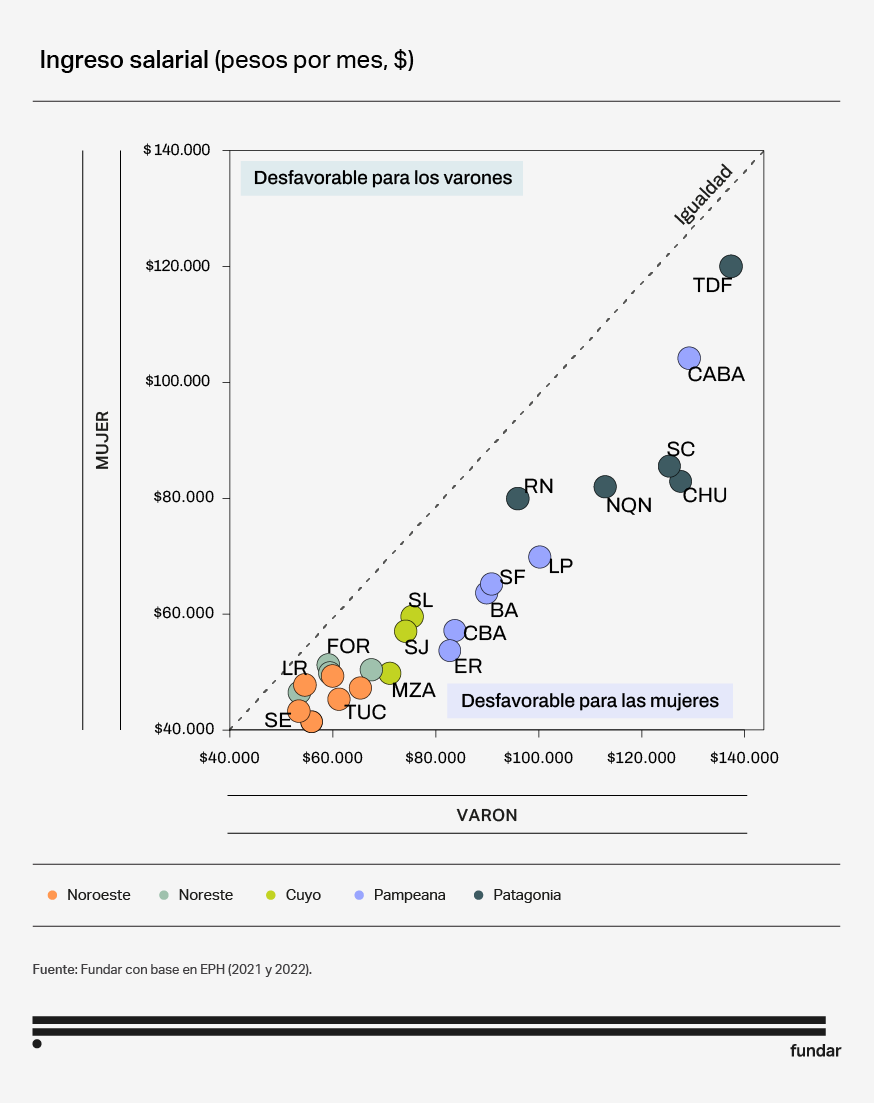
In no province of Argentina do women receive an equivalent average income to men from their primary employment. Additionally, provinces with lower per capita income and lower wages tend to exhibit greater gender equity compared to wealthier counterparts, while provinces characterized by higher wage incomes also tend to experience heightened gender inequality.
The gender division of labor not only constraints women’s capacity to contribute more hours to the workforce, but also shapes the sectors where they may be employed, their relative salaries and the quality of employment. The unequal distribution across occupations and industry sectors, leading to a concentration of women in fields associated with social reproduction (care work) is evident across provinces.
Time use and opportunities: unpaid work, the mother of all battles
Labor market access and professional growth are necessary conditions to earn one’s living and attain financial independence. The unequal representation of women in Argentina’s labor market may be explained by several causes, among them, men’s failure to assume caregiving responsibilities.
Unpaid workday: main explanation for inequality
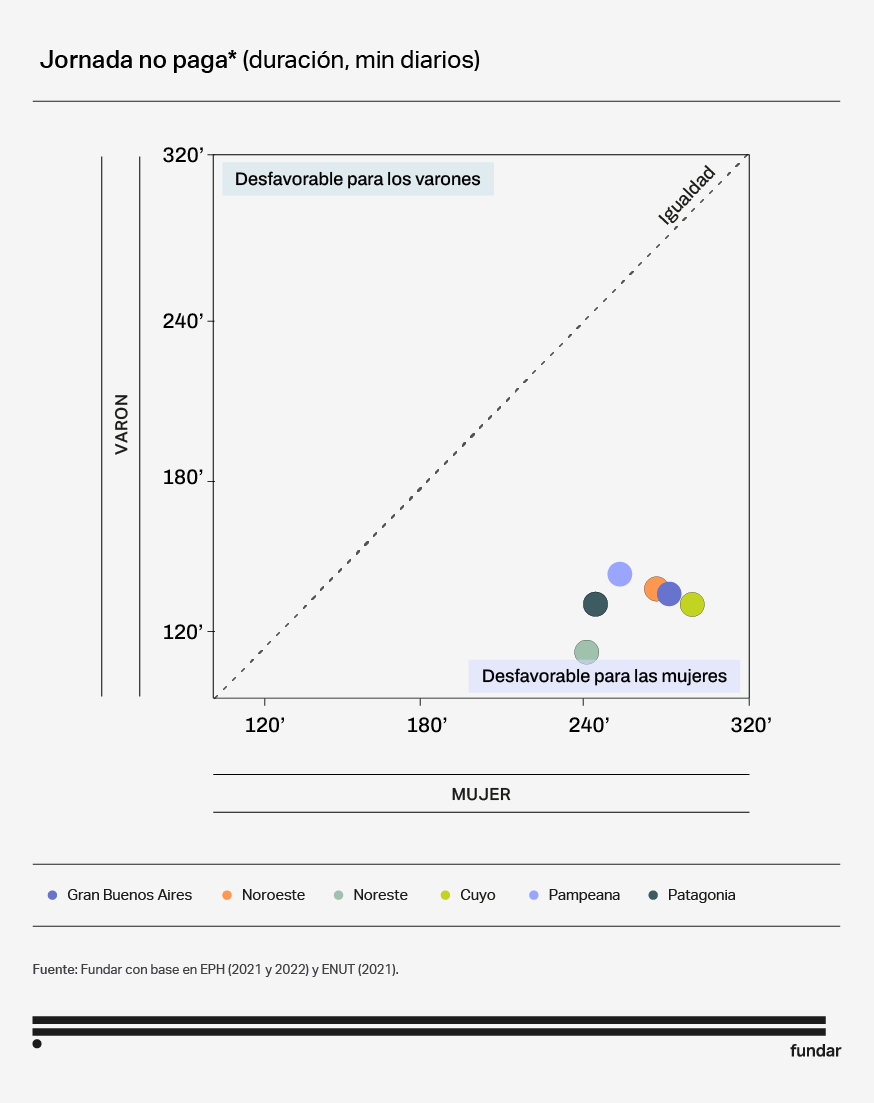
The surge in women’s participation in the paid labor market has not been accompanied by a commensurate redistribution of caregiving responsibilities. Across all regions, women devote no less than 4 hours daily to unpaid work, nearly twice as much as men, who contribute only 2 hours.
Domestic and caregiving work, once overlooked in traditional economic discourse, emerges today as the primary determinant of gender-based economic inequality. Unpaid labor is not isolated from broader socio-productive processes, as the daily burden borne by women underscores deficits not only in equitable distribution among household members, but also in the active involvement of the State.
Household heads: sharing caregiving responsibilities
Men are inserting themselves more and better into paid work because they depend on women continuing to take on twice as much unpaid work.
Men’s increasing and more effective integration into paid employment hinges on the ongoing reliance on women to shoulder twice the burden of unpaid work. These are not two disparate revelations but rather two sides of the same coin.
Male-led households with children or youth under their care account for 87%, while for female heads it is only 43%. In other words, only 13% of households with children or youth under 25 years of age do not have a female presence, while 57% of households with children or youth under 25 years of age do not have a male presence. This data underscores the persistent reliance on women for child-raising.
This is also true for underprivileged single-mother households. Consequently, anti-poverty initiatives must incorporate nuanced public policies in line with these unique family structures and the deeply-rooted gender roles embedded in them.
Own income and non-poverty
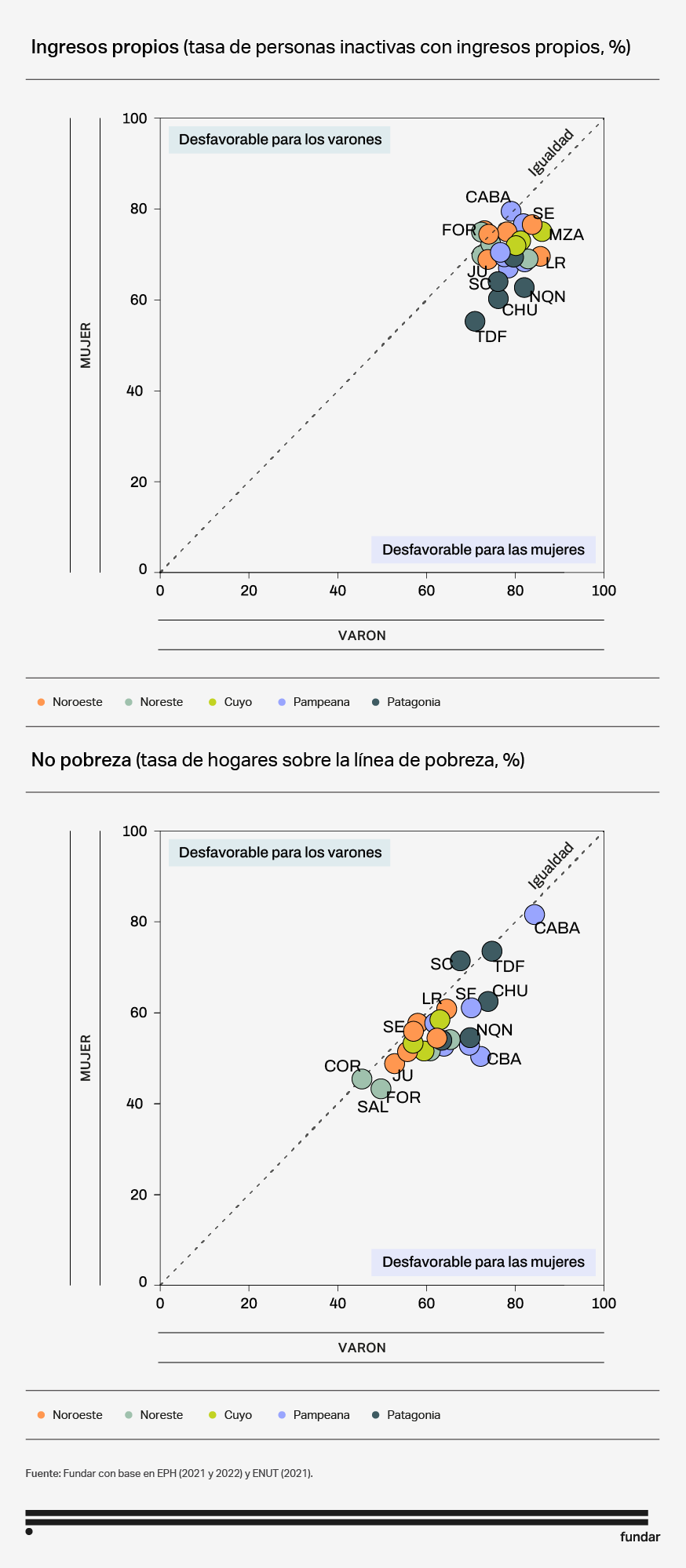
The own income and non-poverty indicators show average scores of 90.3 and 89.4 respectively. In contrast, unpaid work time lags significantly with a score of 49 points.
While both indicators underscore achievements in equality across several provinces, the prevalence of poverty consistently emerges as a more pressing concern than economic dependency. On average, 24% of women find themselves in a state of financial dependency, characterized by inactivity and a lack of their own income. Simultaneously, 43% of households led by women grapple with poverty.
Productive work, reproductive work
This index adequately synthesizes prominent public challenges and the degree of equality achieved within each province. While all aspects warrant attention, it is essential to scrutinize the root causes of indicators with suboptimal performance to prioritize urgent intervention measures
The cornerstone of gender disparities in labor integration, income, vulnerability, and susceptibility to poverty lies in the inequitable distribution of domestic and caregiving work.
The theoretical, discursive and practical dichotomy between productive and reproductive spheres proves fictitious, since one is built on top of the other: it is the latter that sustains the former. The labor market could not exist without the life-sustaining work primarily carried out by women.
Visualizing and emphasizing the social and economic value of care is crucial in combating gender injustices. This will enable a gender-sensitive productive policy aimed at bridging gaps in market entry and wage income. However, addressing the core inequality is indispensable, as it perpetuates imbalances across various dimensions of the original asymmetry.
The following link provides access to the repository containing the files used in calculating the Gender, Labor and Income Index developed by Fundar.

